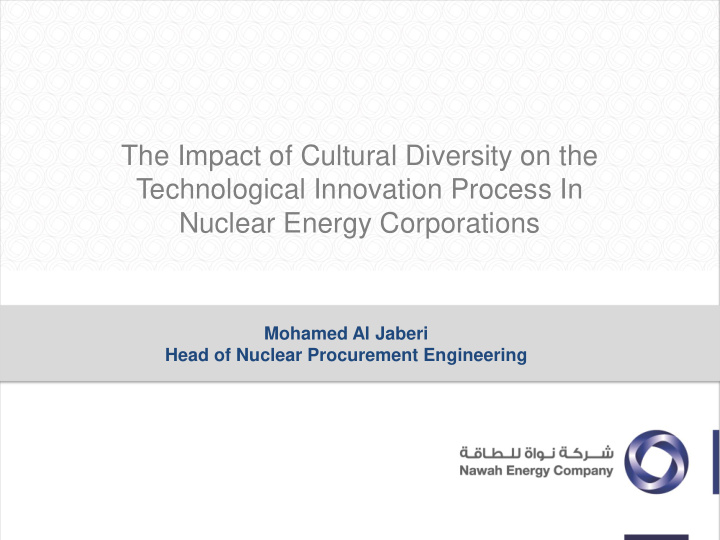



The Impact of Cultural Diversity on the Technological Innovation Process In Nuclear Energy Corporations Mohamed Al Jaberi Head of Nuclear Procurement Engineering
Research Purpose The research attempts to provide an insight into the impact of cultural diversity on the innovations in the nuclear sector, where the UAE is taken as a case study. 2
About Nawah Energy Company • Established in 2016, Nawah Energy Company (Nawah) will operate and maintain Units 1 to 4 at the Barakah Nuclear Power Plant, the first nuclear energy plant in the UAE and the region • Nawah, the world’s newest nuclear operator, will harness the power of nuclear energy to provide a safe, reliable, clean and sustainable supply of low-carbon electricity to contribute to the UAE’s social and economic development and enhance the quality of life for generations to come. • With safety as its overriding priority, and in adherence to the highest international standards in the nuclear industry, Nawah will generate 5,300 megawatts of energy from 2020 onwards, supplying approximately 25% of the UAE’s electricity requirements. 3
Our Shareholders • The Nawah Energy Company is a Private Joint Stock Company (PJSC) co-owned by the Emirates Nuclear Energy Corporation (ENEC) (82%) and the Korea Electric Power Corporation (KEPCO) (18%). 4
Our Stakeholders • Federal Authority for Nuclear Regulation (FANR) : the regulatory body for the nuclear sector in the UAE. FANR fulfills key objectives in licensing and inspection in accordance with best international practices. FANR also oversees the implementation of the UAE’s obligations under the international • International Atomic Energy Agency (IAEA) : IAEA is an international organization that seeks to promote the peaceful use of nuclear energy, and to inhibit its use for any military purpose, including nuclear weapons. • World Association of Nuclear Operators (WANO) : WANO exists to help its members reach the top levels of operational safety through a series of highly regarded programs, such as peer reviews, access to technical support and a global library of operating experience. • Institute for Nuclear Power Operations (INPO) : INPO’s mission is to promote the highest levels of safety and reliability, and to promote excellence, in the operation of commercial nuclear power plants 5
Barakah Nuclear Power Plant • Barakah Nuclear Power Plant (NPP) is situated in the Al Dhafra Region of Abu Dhabi, approximately 53 kilometres west-southwest of the city of Ruwais • Barakah was selected following a comprehensive analysis that lasted for 12 months considering several factors, and in adherence to the best practices and standards from FANR, the Electric Power Research Institute, the U.S. Nuclear Regulatory Commission and the IAEA • Barakah NPP will use the most advanced technology - the Advanced Power Reactor 1400 (APR-1400). The reactor is a 1,400 Megawatt Pressurized Water Reactor (PWR) designed by KEPCO, and meets the highest international standards set for safety and performance 6
Barakah Nuclear Power Plant 7
Research Introduction • The UAE is encouraged to follow research activities to compliment the energy generation project. • Such research will require the development of a research reactor project, which will not only benefit supporting nuclear power plant operations, but also all industries identified in the UAE’s growth strategies. • Innovation is considered as one of the most important processes for enhancing quality and productivity. 8
Research Introduction • This study will focus on the innovation factors within the research process in the nuclear industry. • Knowledge, skills and experience are all considered as critical elements of innovation. • The mobility of people is considered as the key element for transferring these three elements from one country to another. That can be recognized to the fact that a huge amount of the embodied knowledge as well as personal experiences are lost in the process of relocation, which impacts the operability and utilization of the nuclear facility. 9
Methodology • The quantitative data has been collected from survey questionnaire and qualitative information has been collected by interviews. • For the quantitative analysis, one-way ANOVA test was used to test whether the respondents concurred on the influence and cultural diversity on the innovation process. • Furthermore, the Tukey test was used to confirm if there is a difference between the respondents’ categories in the mean rating at the 0.05 significance. 10
Methodology • Concerning the interviews, the grounded theory techniques were employed to thematise, code, and establish the propositions based on the top managers responses. • For this research, purposive sampling has been chosen to ensure the nuclear characteristics of the sample- nuclear staff with research reactors knowledge, to ensure the alignment with the objectives of the study. 11
Demographics 12
Findings & Conclusion • The data findings discovered that communication cost, access of market, creative ideas, as well as resource allocations are the highly significant aspects of the innovation process in the nuclear sector. • The importance of available finance to pay for the different expenses of the research and development programs that inspire and motivate technological innovation. • Further there should be an easy access to science, technology and business best practices. • The driving forces for nuclear energy and research innovation are the market drivers, the political or public drivers and technical drivers. • Finally, English proficiency is required based on the rapid growth and recruitment of different multi cultural employees. 13
14
Thank you
Recommend
More recommend